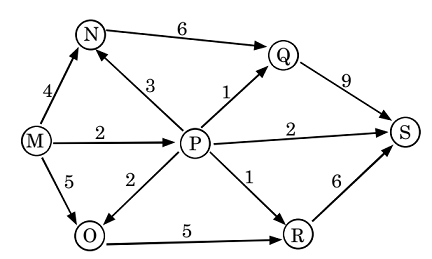Routes and Networks
Direction: Natural gas once extracted from a source is purified for commercial use at natural gas plants. From gas plants it is pumped to various destinations through pipelines. There are pumping stations, at intermediate places to maintain recommended pressure in the pipelines. The pumping stations do not produce or process any natural gas. They pump out exactly the quantity they receive from plants or other pumping stations. The following figure depicts a network gas pipelines. The circles denote the locations of gas plants, pumping stations or cities with big demand for natural gas. One location can be only one of these three. The numbers on the arrows are the capacities (in appropriate units) of the pipeline that carry gas in the direction of the arrow. Currently the demand supply situation is such that the capacity utilization of the pipelines is very close to 100%.

- What is the maximum quantity of natural gas S can receive?
-
View Hint View Answer Discuss in Forum
From the above given figure ,
The maximum quantity of natural gas that S can receive = 6 + 2 + 9 = 17 units.Correct Option: D
From the above given figure ,
The maximum quantity of natural gas that S can receive = 6 + 2 + 9 = 17 units.
Therefore , required answer will be 17 units.
- For which 2 cities it can be safely concluded that they have natural gas plants?
-
View Hint View Answer Discuss in Forum
We know that cities M and P are gas plants.
Correct Option: A
We know that cities M and P are gas plants.Hence , option A will be correct answer .
- What is the maximum quantity of natural gas than can be transported from M to R?
-
View Hint View Answer Discuss in Forum
From the above given figure and the conditions R can receive only 6 units (5 + 1) of natural gas if utilization is 100%.
Correct Option: D
From the above given figure and the conditions R can receive only 6 units (5 + 1) of natural gas if utilization is 100%.
Therefore , required answer will be 6 units.
- Eight cities A, B, C, D, E, F, G and H are connected with one-way roads R1, R2, R3, R4, R5 and R6 in the following manner:
R1 leads from A to C via B;
R2 leads from C to D and then via B to F;
R3 leads from D to A and then via E to H;
R4 leads from F to B via G;
R5 leads from G to D; and R6 leads from F to H.
The minimum number of road segments that have to be blocked in order to make all traffic form B to D impossible is
-
View Hint View Answer Discuss in Forum
On the basis of above given question , we can say that
We can block B to D if A to B means R1 and B to F means R2 is blocked.Correct Option: D
On the basis of above given question , we can say that
We can block B to D if A to B means R1 and B to F means R2 is blocked.
Therefore minimum 2 ways needed to be block.
- In the adjoining figure, the lines represent one-way roads allowing travel only northwards or only westwards. Along how many distinct routes can a car reach point B from point A?

-
View Hint View Answer Discuss in Forum
Here , number of vertical steps ( v ) = 3
Number of horizontal steps ( h ) = 5Correct Option: B
Here , number of vertical steps ( v ) = 3
Number of horizontal steps ( h ) = 5
Then in this case total number of ways is given by h+vCh = h+vCv = 8C3 = 6 x 7 x ( 8/6 ) = 7 x 8 = 56.
Hence , 56 distinct routes can a car reach point B from point A .

